Partner in Health
Collins Shares His Experience with Prostate Cancer

Photo: Diane Baker
A medical school professor once told Dr. Francis Collins: if you’re going to get sick, at least try to be an interesting case. Collins inadvertently took that advice to heart earlier this year when he found himself not on the familiar physician-researcher side of NIH, but rather as a surgical patient.
Earlier this year, Collins was diagnosed with an aggressive form of prostate cancer. For five years, his doctor had been monitoring a modestly elevated PSA blood test associated with a rather unimpressive prostate MRI lesion, something common in men his age. Collins wasn’t worried. But then something changed, and the new diagnosis took him by surprise.
“I’m an outlier,” said Collins. “Most of the time when doctors do this kind of active surveillance with repeated testing, images and biopsies, men tend to stay in the same pattern for a long time. If you start out, as I did, as a Gleason-6 [on the prostate cancer grading scale], you often stay there for a decade or more. I broke the rules.”
NIH Protocol
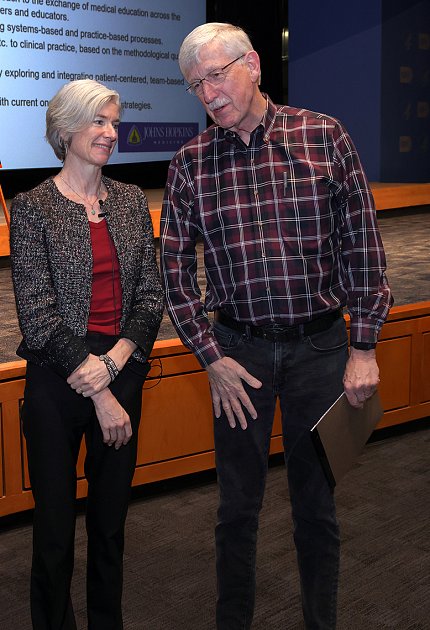
Photo: Chia-Chi Charlie Chang
Five years ago, Collins’s doctor informed him of a slightly elevated PSA—the blood test for prostate-specific antigen. This health change inspired Collins to enroll in an NIH clinical protocol to monitor and test ways to improve screening and managing cancer.
“I was glad to serve as another data point they could add to this long-term study,” said Collins, who has dedicated his career to studying genetics and helping others—as former NIH director (2009-2021), former National Human Genome Research Institute director, current NHGRI distinguished investigator and, most recently, a patient partner in research.
Collins knew he had a higher risk of developing prostate cancer. His father had been diagnosed with the disease 40 years ago and suffered significant side effects from treatment.
When Collins saw his PSA go outside the normal range, he said, “I did my own due diligence, checking out what other institutions do in that circumstance, reading the literature. And, I concluded that our own doctors at the NIH Clinical Center were on the leading edge of research and clinical care. I concluded they were the people I could most count on to take care of me and make sure that whatever happened could add to the body of knowledge about this disease.”
“Our prostate MRI scan saw his tumor,” said Dr. Peter Pinto, senior investigator and urologic surgeon in the National Cancer Institute’s (NCI) Urologic Oncology Branch, who heads the clinical protocol. “We biopsied it multiple times over the years and it remained low grade. Then something changed in the biology of his cancer.”
For a PSA test, less than 5 is considered normal. In March, Dr. Collins’s PSA jumped to 22. A targeted biopsy showed the tumor had become a Gleason-9, on a scale that only goes to 10. The aggressive cancer was pushing through the outer layer of the prostate, but a very sophisticated PET scan with high sensitivity for prostate cancer cells found no sign of distant spread.
“The images showed my cancer had grown and spread itself around like a crescent and might have breached the capsule,” recounted Collins. “Then it was time to act.”
Surgery
On April 26, Collins underwent a radical prostatectomy, which removes the entire prostate gland and surrounding lymph nodes.
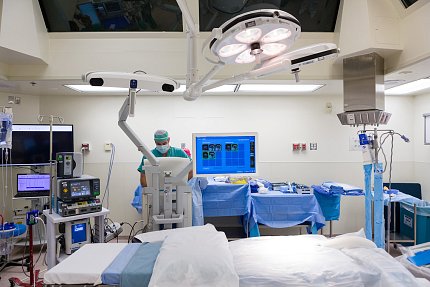
Photo: Clinical Center Department of Perioperative Medicine
“Today, this surgery is less invasive with better imaging and there’s less blood loss,” said Pinto, who was the lead surgeon. “You can go back to work sooner. You recover faster.”
Pinto performed a robot-assisted laparoscopic surgery. In the operating room, Pinto used the prostate MRI to guide the surgery “to improve [the chances of] removing all the cancer in the areas where it appeared to be breaking out,” he explained.
“When I remove the prostate, we go wide where we have to” with the goal of getting clean margins so no cancer is left behind. Using the MRI, he added, “enhances our ability to spare the muscles and nerves around the prostate to reduce the risk of side effects.”
Collins knew post-surgery incontinence was a possibility. “It’s a reality of what happens when you rearrange the plumbing down there,” he said. “That was my experience [initially], but it’s getting much better now.”

Photo: Chia-Chi Charlie Chang
A few days after surgery, Collins was re-admitted to the Clinical Center with a gastrointestinal complication that was swiftly addressed by his care team. A few days later, Collins had another unpleasant surprise: he got shingles, despite being fully vaccinated. “There’s a pretty big stress to the body with major surgery. I guess the immune system was distracted and the sleeping chickenpox virus took advantage,” Collins said.
The surgery was a success. “Using surveillance—PSA testing, MRI and biopsies—we caught the cancer before it became metastatic,” said Pinto. And, on July 31, Collins received a happy lab result, when his PSA was undetectable, less than 0.1. He’ll need to have this checked every three months for the next couple of years, but the signs now are really good.
Pinto said, “It’s great to see Dr. Collins benefit from all the work he supported as director here for so many years.”
Precision
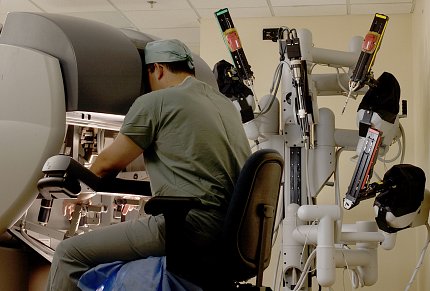
Prostate cancer screening and surgical techniques have come a long way over the past decade, thanks to imaging technology pioneered by NIH.
For many years, Pinto was frustrated by testing methods that frequently led to overtreatment or missed aggressive cancer entirely, a standard of care that confounded doctors and left patients leery of getting tested in the first place.
“As a urologist, the idea of a PSA screening test leading to a prostate biopsy that was “blind” to the tumor location really disturbed me,” said Pinto. “I couldn’t think of any other solid cancer where a blood test led to a biopsy of the organ that was not directed to where the tumor was, instead just hoping to hit the cancer.” For decades, that was what doctors did. “I came to NIH to solve this problem.”
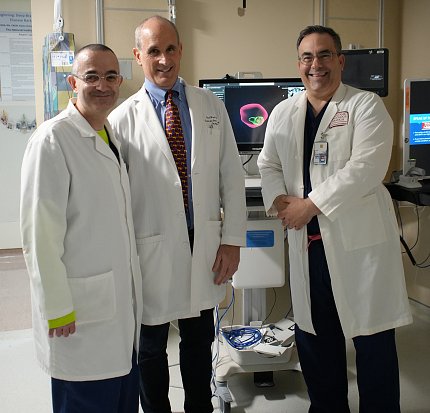
Photo: Dana Talesnik
Pinto has worked at NIH for 21 years, collaborating with the same prostate imaging team—radiologists Dr. Peter Choyke, Dr. Ismail Baris Turkbey and Dr. Brad Wood, and pathologist Dr. Maria Merino—who together have changed the way prostate cancer is now detected.
Today, clinical guidelines advise a prostate MRI should accompany the PSA test if cancer is suspected. Now, if further testing is needed, there are new devices that offer a targeted biopsy. The biopsy device combines prostate MRI with ultrasound to direct the biopsy needles into suspicious cancer areas and can be performed in a doctor’s office.
“Over the past 20+ years, our NIH prostate team, working with medical industry partners, has taken this new biopsy device, UroNav, from concept to commercialization,” Pinto said. “We built it from the ground up and now MRI-directed fusion biopsies to diagnose prostate cancer is pretty much standard of care.”
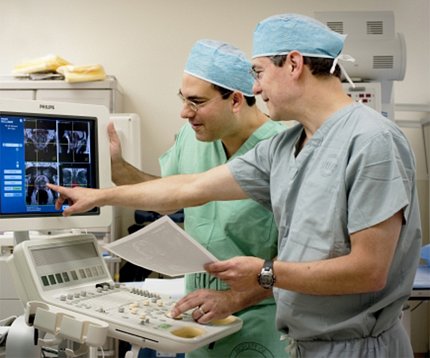
Photo: NCI
With this imaging fusion technology, Collins commented, “You can be confident, when you do it this way, that the biopsies really are reflecting what’s going on and you haven’t missed the most important part of the prostate.”
Now, the NIH team has begun developing artificial intelligence analysis to better detect and confirm tumor characteristics. Pinto also is working on decreasing the harms of current treatments through his NIH clinical protocols that destroy just the tumor(s) within the prostate, an emerging field called focal therapy.
Someday, these advances will help determine which patients with prostate cancer will never need treatment and which may progress over time. Active surveillance is key. Pinto said, “If you could ensure the cancer is low grade and will not over time change, so you will die with it not from it, then we can just [watch it] and leave you alone.”
Care
Collins is grateful to have received his care at NIH.
“It was incredibly reassuring to see the remarkable compassion and excellent science and medical care that I received at the Clinical Center,” Collins said. “I can’t say enough about how impressive their team was with every detail.”
From the surgery, imaging and pathology team to the urology fellows to the nurses, “Everyone involved in my care was unfailingly polite, courteous, reassuring and supportive,” he added. “So I feel really good about this personal insight into the kind of care the NIH Clinical Center gives to people from all over the world who come here.”
Hope
Prostate cancer is still the second leading cause of cancer death for men and the most common non-skin cancer in men. But NIH-led advances in screening, detection and management are offering new hope.
“As we see these new technologies and advances from our clinical protocols become adopted more widely, we expect death rates will drop,” said Pinto, “and there will be less pain and suffering.”
Collins continues to candidly discuss his prostate cancer journey to impart lifesaving information. “I’m trying to be as transparent as possible,” he said. “I hope my experience will benefit others.”
